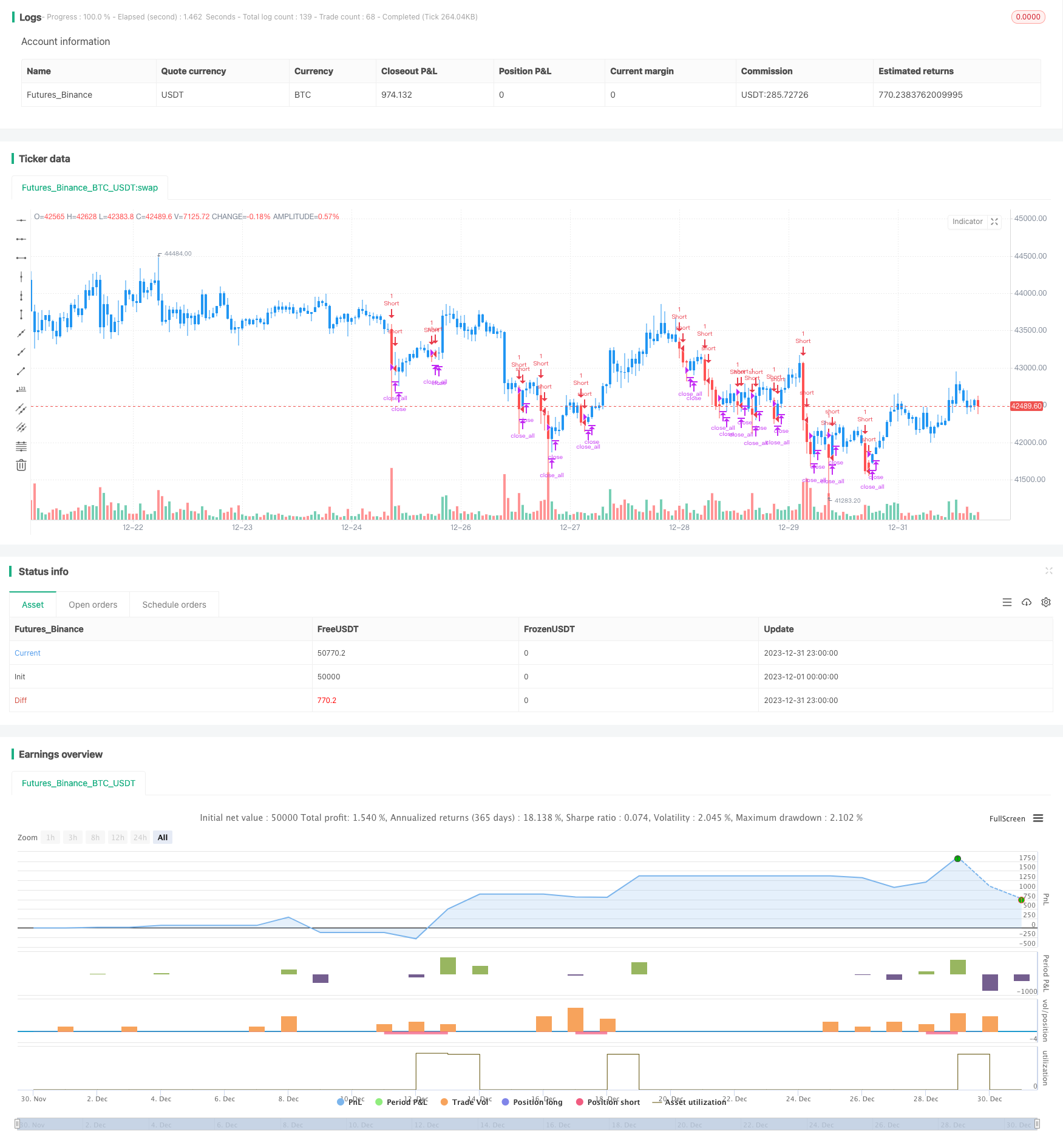Peanut 123 Reversal and Breakout Range Short-term Trading Strategy
Author: ChaoZhang, Date: 2024-01-29 16:31:04Tags:

Overview
The Peanut 123 Reversal and Breakout Range Short-term Trading Strategy is a combination strategy that incorporates the signals from a reversal strategy and a breakout strategy sub-strategies to generate more powerful trading signals.
Strategy Logic
The strategy consists of two sub-strategies:
-
Peanut 123 Reversal Strategy
It is an adapted reversal strategy based on the system introduced on P183 of Ulf Jensen’s book. It goes long when the close price rises for 2 consecutive days and the 9-day Stochastic Slow line is below 50; It goes short when the close price falls for 2 consecutive days and the 9-day Stochastic Fast line is above 50.
-
Breakout Range Short Strategy
It is a short-term strategy that uses the breakout of the lowest price in a certain look_bak period as the signal. It goes short when the price breaks below the lowest low in the look_bak period.
The combination strategy takes into account the signals from both sub-strategies. It generates actual trading signals only when the two sub-strategies give signals in the same direction. No trading signals will be generated if the two sub-strategies give opposite signals.
Advantage Analysis
The strategy combines the advantages of both reversal and breakout sub-strategies and considers more factors. It can filter out some noise trades and improve win rate.
-
The reversal strategy captures short-term reversal opportunities and makes profit during fluctuations.
-
The breakout strategy catches the short-term trend after the breakout.
-
By combining the signals of two sub-strategies, more effective trading signals can be generated and noise can be filtered out.
Risk Analysis
The strategy also has the following risks:
-
Reversals may not happen, there are risks of failed reversals.
-
Breakouts can also be false breakouts, there are risks of chasing highs and lows.
-
Neither of the sub-strategies can ensure effectiveness when used alone, combining them may also fail.
To address these risks, methods like optimizing parameters, adjusting the weighting of sub-strategies, choosing different products for arbitrage can be used to reduce risks.
Optimization Directions
There is room for further optimization of the strategy:
-
Optimize the parameters of the two sub-strategies to better adapt to different cycles and different products.
-
Increase other types of sub-strategies, such as machine learning prediction strategies, to incorporate more factors.
-
Dynamically adjust the weighting of the two sub-strategies to give more weight to the better-performed one in different market environments.
-
Conduct combination arbitrage by selecting products with little correlation but certain commonality.
Summary
The Peanut 123 Reversal and Breakout Range Short-term Trading Strategy integrates the reversal and breakout sub-strategies at the strategy level. To some extent, it combines the advantages of the two sub-strategies while having space for further optimization. It provides new ideas for strategy design - conducting integration and combination at the strategy level while preserving the independence of sub-strategies, in order to discover more effective trading opportunities.
/*backtest
start: 2023-12-01 00:00:00
end: 2023-12-31 23:59:59
period: 1h
basePeriod: 15m
exchanges: [{"eid":"Futures_Binance","currency":"BTC_USDT"}]
*/
//@version=4
////////////////////////////////////////////////////////////
// Copyright by HPotter v1.0 01/07/2019
// This is combo strategies for get a cumulative signal.
//
// First strategy
// This System was created from the Book "How I Tripled My Money In The
// Futures Market" by Ulf Jensen, Page 183. This is reverse type of strategies.
// The strategy buys at market, if close price is higher than the previous close
// during 2 days and the meaning of 9-days Stochastic Slow Oscillator is lower than 50.
// The strategy sells at market, if close price is lower than the previous close price
// during 2 days and the meaning of 9-days Stochastic Fast Oscillator is higher than 50.
//
// Second strategy
// Breakout Range Short Strategy
//
// WARNING:
// - For purpose educate only
// - This script to change bars colors.
////////////////////////////////////////////////////////////
Reversal123(Length, KSmoothing, DLength, Level) =>
vFast = sma(stoch(close, high, low, Length), KSmoothing)
vSlow = sma(vFast, DLength)
pos = 0.0
pos := iff(close[2] < close[1] and close > close[1] and vFast < vSlow and vFast > Level, 1,
iff(close[2] > close[1] and close < close[1] and vFast > vSlow and vFast < Level, -1, nz(pos[1], 0)))
pos
BreakoutRangeShort(look_bak) =>
pos = 0
xLowest = lowest(low, look_bak)
pos := iff(low < xLowest[1], -1, 0)
pos
strategy(title="Combo Backtest 123 Reversal & Breakout Range Short", shorttitle="Combo", overlay = true)
Length = input(14, minval=1)
KSmoothing = input(1, minval=1)
DLength = input(3, minval=1)
Level = input(50, minval=1)
//-------------------------
look_bak = input(4, minval=1, title="Look Bak")
reverse = input(false, title="Trade reverse")
posReversal123 = Reversal123(Length, KSmoothing, DLength, Level)
posBreakoutRangeShort = BreakoutRangeShort(look_bak)
pos = iff(posReversal123 == 1 and posBreakoutRangeShort == 1 , 1,
iff(posReversal123 == -1 and posBreakoutRangeShort == -1, -1, 0))
possig = iff(reverse and pos == 1, -1,
iff(reverse and pos == -1, 1, pos))
if (possig == 1)
strategy.entry("Long", strategy.long)
if (possig == -1)
strategy.entry("Short", strategy.short)
if (possig == 0)
strategy.close_all()
barcolor(possig == -1 ? color.red: possig == 1 ? color.green : color.blue )
- RSI Indicator Based Stock Trading Pyramiding Strategy
- All about EMA Channel Trading Strategy
- Double Decker RSI Trading Strategy
- Bollinger Bands and RSI Combination Strategy
- Double Inside Bar & Trend Strategy
- Amazing Price Breakout Strategy
- Robust Trend Continuation Strategy
- Trend Tracking Moving Average Crossover Strategy
- Breakout Reversal Model Based on Turtle Trading Strategy
- Momentum Trend Strategy
- Smoothed RSI Based Stock Trading Strategy
- Smooth Volatility Band Strategy
- Commodity Channel Index Reversal Trading Strategy
- Time-based Strategy with ATR Take Profit
- Momentum Trend Tracker Strategy
- EMA Candle Close Strategy
- EMA Crossover Quantitative Trading Strategy
- Dynamic Stop-Loss Moving Average Strategy
- Mean Reversion with Incremental Entry Strategy
- Dynamic Average Price Tracking Strategy